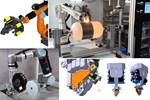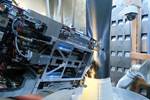Electroimpact offers variable spot size laser AFP 4.0 technology
Patented process technology increases quality, reliability and machine utilization for composite laminate production.
Source | Electroimpact, via LinkedIn
The variable spot size laser (VSSL) by Electroimpact’s (Multikeo, Wash., U.S.) automated fiber placement (AFP) group reportedly offers a new level of performance in automated composites manufacturing.
The VSSL is noted for its quality of lamination. The system delivers the right amount of heat for each individual tow, resulting in consistent tow tack even when adding at 4,000"/min. Tow end placement is highly accurate and consistent due to improved tension and tow tack.
Optimized tack means no missed tows, Electroimpact emphasizes, especially short tows, and thus a more reliable process. The servo-creel is a high-performance tension system that assures no slack and therefore no tow twists are possible. Because only the active tows are being heated and because the heat arrives at the moment the new tow meets the nip, there is no chance for a compaction roller wrap.
The VSSL laser and servo-creel enable 4,000"/min adds and 3,000"/min cuts, enhancing performance capabilities. Moreover, utilization has been increased, as the system is said to eliminate any rework or process error recovery.
For more information, see .
Related Content
-
Airbus video highlights RACER compound helicopter first flight
Launched as part of a Clean Sky 2 program, a compound design — rotor, split fixed-wing, propulsive propellers — uses composites to cut fuel consumption and emissions by 20%.
-
Combining multifunctional thermoplastic composites, additive manufacturing for next-gen airframe structures
The DOMMINIO project combines AFP with 3D printed gyroid cores, embedded SHM sensors and smart materials for induction-driven disassembly of parts at end of life.
-
The next evolution in AFP
Automated fiber placement develops into more compact, flexible, modular and digitized systems with multi-material and process capabilities.






